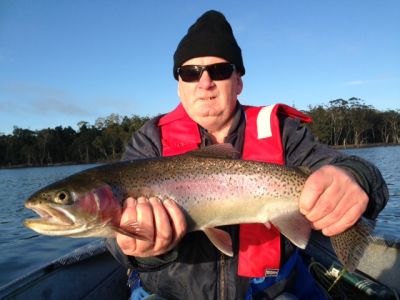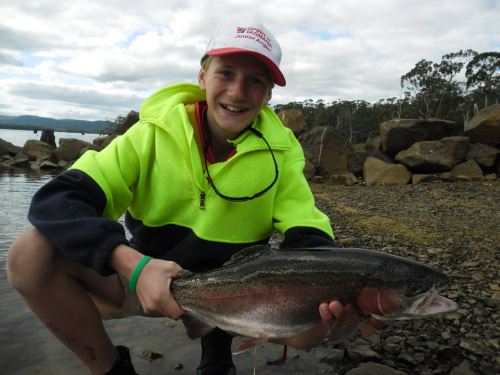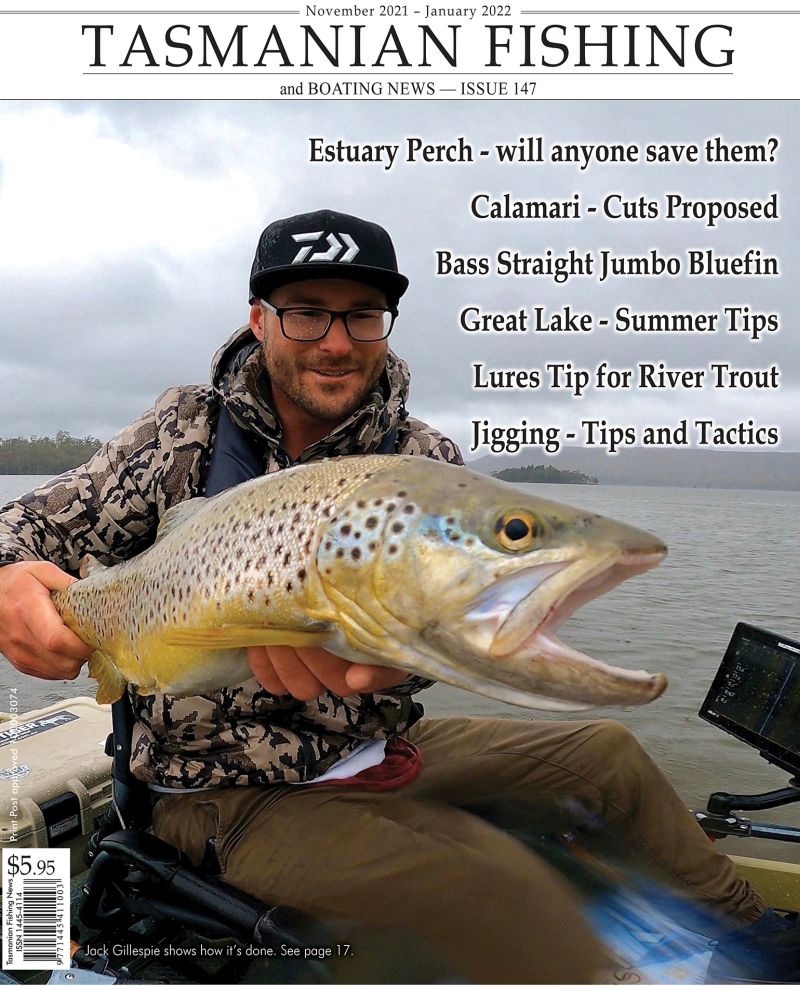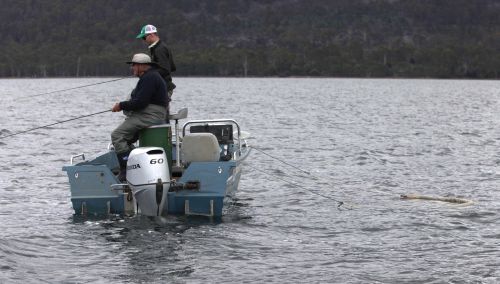From the Archives ...
Sea run trout tactics – Craig Vertigan
Sea run trout tactics – Craig Vertigan
During the trout off-season I tend to spend a bit of time chasing bream, to continue getting a fishing fix, and spend time tying flies and dreaming about the trout season to come. It’s a time to spend doing tackle maintenance, stocking up on lures and dreaming up new challenges and goals for the trout season ahead. When the new season comes around I usually spend the first few months targeting sea runners. Sea run trout are simply brown trout that spend much of there lives out to sea and come in to the estuaries for spawning and to feed on whitebait and the other small endemic fishes that spawn in late winter through spring. Mixed in with the silvery sea runners you can also expect to catch resident fish that have the typical dark colours of a normal brown trout as well as atlantic salmon in some of our estuaries that are located near salmon farm pens. Living in Hobart it is quick and easy to do a trip on the Huon or Derwent and is a more comfortable proposition compared to a trip up to the highlands with snow and freezing winds to contend with.
Read more ...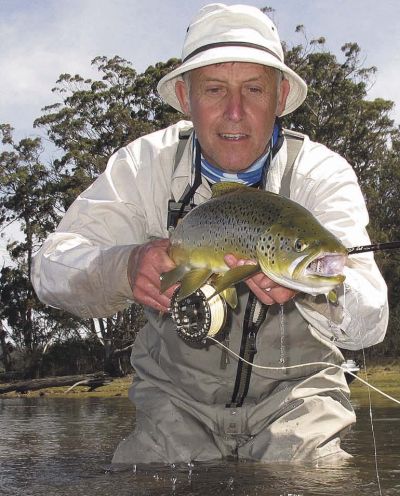 Presented from Issue 113, December 2014
Presented from Issue 113, December 2014
Lake Leake has been a water I have fished infrequently, but for many years. It has great history as a water supply and an up and down ride as far as a fishery goes. I t is smallish and relatively shallow and has in the past hosted some fantastic early morning midge hatches and outstanding mayfly hatches.
Its waters contain brown and rainbow trout, brook trout in the past and many small redfin, plus a few big ones.
A recent trip with a mate Bob started at 3am and 5am on the water. It was filled with expectation of an early morning midge hatch, with rising fish expected all over the lake. That didn’t happen.
- Written by Stephen Smith - Rubicon Web and Technology Training
- Category: Lake Leake
- Hits: 4601
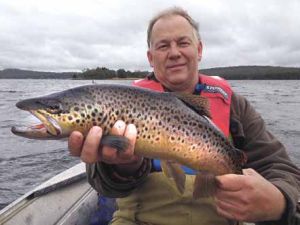 Presented from Issue 109, April 2014
Presented from Issue 109, April 2014
Situated approximately 1 hour and 20 minutes from Launceston is a water that flies under the radar of many…Lake Leake.
Although a fair bit has been written about it over the years, this water remain largely underutilised and doesn’t receive the amount of attention from anglers as it deserves. Both browns and rainbows inhabit this water and they can be quite a size.
They are perhaps the best average size of any water in Tasmania.
- Written by Stephen Smith - Rubicon Web and Technology Training
- Category: Lake Leake
- Hits: 7017
Dawn ‘n’ Dusk
Many anglers know, dawn and dusk are the best times to be on the water to maximise one’s chances of success. But how many regularly get out of bed early and experience the magic of first light—breaking over one of our lakes and rivers. To be in the half light waiting for the sound of a trout slurping a morsel off the top of the water, or in some cases leaving a ring that is barely visible to the naked eye.
The fish are there, and they are there in numbers and more often than not they are feeding hard. They often continue to do so until the sun burns off the cloud cover and puts them down to seek refuge in the depths below. I talk mostly in this article about Lake Leake, but a lot of what I say is relevant around the state.
Dawn
It’s 4 am and the alarm goes off breaking the nights silence, my wife sighs and mutters something that sounds unfavourable. I am pretty sure I heard the words ‘you’re bloody mad’ in there somewhere and for a few fleeting seconds.. I agree.
Then the thoughts of feeding trout invade my head and in no time at all I find myself in the car heading to one of my favourite fishing destinations—Lake Leake.
In this article I would like to share some information on this ‘early morning water’ that will hopefully lead to some success for you.
I hold few secrets when it comes to sharing experiences and information because as far as I am aware no lake or streams have ever been ruined by doing so and as we all know just because one witnesses success one day, it doesn’t always translate to the next.
Lake Leake
Lake Leake has had some very ordinary reports written on it of late with people saying that the fishing there is very challenging.
A couple of my mates and I disagree with that line of thinking, as recent trips to this water have resulted in us catching our bags in a very short period of time. If I was a betting man, I would envisage that those not fairing that well there are probably arriving well after all the action has happened....dawn.
This water is an amazing fishery for early morning midge feeders, in fact I would go so far as to say you would be hard pressed not to find feeding fish on top at this time of year if the conditions are right.
A perfect morning here is a light southerly and an overcast sky, and I emphasise the overcast sky, for without that, it’s all over by around 8.30 am, but sometimes that’s all you need as the five fish bag limit is often taken by anglers ‘in the know’ by that time anyway.
It is a cocky feeling one gets when talking to someone who has just arrived at the boat ramp as you are packing up to head home. They admire your catch and you know they will probably have to work very hard to achieve the same results.
They might ask us what fly we used, where we went etc and I am happy to tell them. I even give them a couple of the flies, but unfortunately most of the action is over.
Early morning methods
Right, you have done all the right things and arrived at Lake Leake as daylight is breaking What to do now? My suggestion is to engage the electric motor, and slowly move around the lake until you spot a wind lane with a bit of insect life in it, then just sit there........for they will come.
Unless you have an experienced eye, you may not notice feeding fish at first, as many just sip their tucker from under the surface, the only giveaway is the slightest ring left on the water.
Even when you do pick up the path of a feeding fish, they can still be very hard to follow; this makes for very challenging and sometimes very ‘frustrating’ fishing indeed.
That being said, every trip is a new adventure, last time we encountered fish charging past the boat with their heads out of the water and mouths open like one of those ‘whale sharks’ you see on the discovery channel.
If you’re a long accurate cast, you hold a distinct advantage as this gives you more chances at the fast moving rainbows before they spot you.
As for myself, I am not the greatest of casts therefore I improvise by sitting down low in my boat and by picking the direction a particular fish is heading in, I position myself far enough in front of that fish so as to set a trap by casting my fly in wait for it a couple of meters ahead.
When one is poised ready to strike as the fish works its way closer and closer, it is a magical feeling, especially when the fly is taken,.... the reel screams to life and it all comes together, now that’s worth getting out of bed for!
Flies
Early morning flies for this water need only be as simple as a team of two or three size 12 to 14 black seals fur fly’s with a brown hackle, in fact anything small and ‘red tagish’ like a Zulu dry will work.
Presentation is more important than the fly itself, in my opinion. Sometimes though they seem to ignore it and go under your dries, if you witness this happening, after a couple of times, I suggest you tie a small nymph or stick caddis to your dry fly’s hook shank and hang it six inches under it, this technique usually brings the fussy fish undone.
Dusk
Dusk is another great time to fish! Minimal effort for maximum results (in theory anyway) and I am all for that. As the sun disappears over the hills that surround Lake Leake, the fish, especially in the last half hour of daylight start to look up consistently again, quite often a persistent angler will be greeted with a huge swirl appearing from nowhere next to his boat as a fish charges to the surface, grabs whatever was on top at the time and heads for the bottom again.
An Elk Hair Caddis is a great fly to put on now, especially if there is a good hatch flying around you, beware though as quite often there is no warning of an impending take, they just want to smash it!!
Other great flies to try are the Johnny Dekkers’ “Purple People Eater” (a purple woolly bugger with an orange tail) or a buoyant mudeye pattern pulled along the top of the waves in short sharp strips.
It might appear like lunacy casting blind in the dark to noises or the glimpse of a ripple that didn’t look quite natural, but if you’re going to get a big fish, now is the time. You don’t have to ‘see’, you only have to ‘feel’ when the line goes tight and you hook up.
Soft Plastics too
With the huge advances in soft plastics that have come forward in recent years, this is another method that produces fantastic results in the darker hours.
Today we are spoilt for choice and the variations of softies in different colours and scents, pre rigged or unrigged, nowadays, seem endless.
I love to fish with plastics early and late in the season especially at dawn as these are the times of the year when the fish are eager to put on condition and they seem to be looking for something a bit more substantial in their diet on a more consistent basis. The fishing can be fantastic, especially if your after that monster!
The big advantage with this form of fishing is depending on the level of water you are fishing in and the size of the jig head you are using, you can cover a lot more territory with the added advantage of longer casts, enabling the angler to reach the depth’s required when necessary.
I have caught many fish with soft plastics in early morning wind lanes , (especially rainbows), after spotting a boil or rise and then casting a couple of meters in the direction upon which I think the trout is heading, I then try to retrieve the plastic past the fishes nose.
Once again, the strikes can be very aggressive, morso before full daylight.
My personal favourite plastics are Berkley gulp pumpkinseeds and the Tassie Yep “Red rascal” and “Flapper” range in both the pre rigged and unrigged versions.
As mentioned earlier, I’ve used Lake Leake as an example in this article, mainly because it is one of my favourite waters, but the same techniques and tips could be applied to Burbury, Huntsman, Four Springs, Brumbys Creek etc, etc with equal success, these methods work for me and work well, I am just an everyday angler with no great skill set to fall back on, just a fair bit of experience collected from over four decades of fishing our fantastic Tasmanian lakes and rivers.
By making the effort to get up early or by heading out after tea to fish the evening until dark, I do catch fish regularly and so will you.
Todd Lambert
- Written by Stephen Smith - Rubicon Web and Technology Training
- Category: Lake Leake
- Hits: 5626
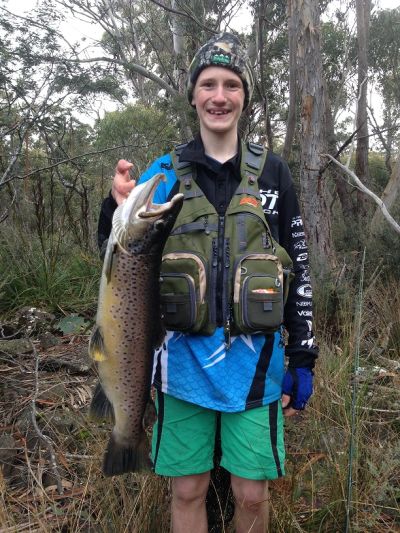 Lake Leake Report 9/8/2015
Lake Leake Report 9/8/2015
Connor caught this cracking 7.15pound 680mm Brown Trout from Lake Leake today.
Biggest I have seen from the lake in a very long time!
Thought you might like the pictures!
Cheers
Samuel
Click Read More for picture.
- Written by Stephen Smith - Rubicon Web and Technology Training
- Category: Lake Leake
- Hits: 6690
 Lake Leake 9/02/2015
Lake Leake 9/02/2015
Fit healthy fish having a devil of a time on a cool evening
With the lake waters still around the 20°C and a cool evening with a north easterly wind, we decided to take my sister’s boyfriend Joe out for a fish on the lake, as he had never caught a trout before.
- Written by Stephen Smith - Rubicon Web and Technology Training
- Category: Lake Leake
- Hits: 6488
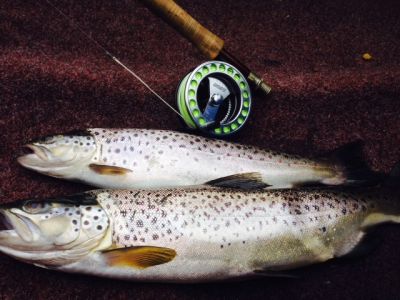 Lake Leake 16/11/2014
Lake Leake 16/11/2014
Left home at 4am, the Sun was well and truly up when I arrived. The water was like glass, fish on top everywhere after midge. Spooky as hell .Managed 2 on the fly and lipped another three... Too quick on the strike. I trolled a soft plastic around whilst looking for solidly feeding fish and had a brown that would have easily went 4 -5 pounds jump 3 times and spit the hook, also had another big grab for a solid head shake but no hook up.... T/ tails.
- Written by Stephen Smith - Rubicon Web and Technology Training
- Category: Lake Leake
- Hits: 6938
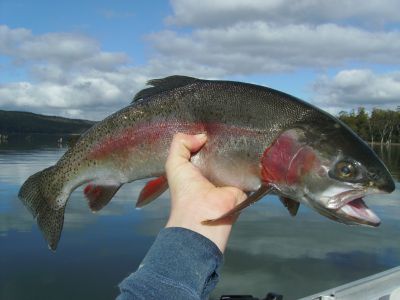 Lake Leake Report 17/8/2014
Lake Leake Report 17/8/2014
The first entry in the "Win a Groper Bandana" Competition!
With not a breath of wind and the sun shining, Connor and I decided to go for a "Late Morning Fish". We hit the water by 11am, and were soon trolling. We both had on Tassie Devil lures, an S11 Funky Frog for me, and a #110 Perch for Connor.
We were soon up past Clark’s point, when Connor says, “Let’s pull in here and have a flick or two”. I changed my lure to a Moore soft plastic, in a pumpkin seed colour rigged up with a 1/12 jig head.
First cast, it was near a big old stump, I let it drop, and picked it back up, let it drop again, and I felt a tap, I then was on! I set the hook, and it was the battle between me and this fish!
I wasn’t letting this on get off.
- Written by Stephen Smith - Rubicon Web and Technology Training
- Category: Lake Leake
- Hits: 7980
Lake Leake 29/8/2014
Lake Leake continues to give up some nice fish although the time put in to achieve these results is often long and arduous .Pictured is Noel Washington of Hobart with a couple of quality fish (out of his bag of four) landed in a recent early morning session .
- Written by Stephen Smith - Rubicon Web and Technology Training
- Category: Lake Leake
- Hits: 5533
Lake Leake Boys
- Category: Lake Leake
- Hits: 5726
Lake Leake Report 6/4/14
- Category: Lake Leake
- Hits: 6872
Current TFBN
Click above for current issue content. The current issue of TFBN is extensive and topical. In Tackle Stores, Newsagents and by subscription.
Delivered to your door for $48 for 2 years (8 issues). To subscribe, send Mike $48 via www.paypal.com.au . (Basic instructions are here) The email is at Contact Us. Your address will be included from PayPal.
Or phone Mike with your c/c handy on 0418129949
Please ensure your details are correct, for Mike to organise delivery.
TFBN Newsletter Sign up Form
Why not submit an article ?
When you have finished for the day, why not have a brag about the ones that didn't get away! Send Mike an article on your fishing (Click here for contact details), and we'll get it published here. Have fun fishing - tasfish.com
Category Descriptions
Here is a list of all of the Article Categories. The number in Brackets, eg (13) is the number of articles. Click on Derwent River and all articles relating to the Derwent will be displayed in the central area.
Articles by Category
-
Rivers (3)
-
Saltwater and Estuary Fishing (149)
-
Kayak Fishing (34)
-
Lakes (1)
-
Great Lake (62)
-
Lake Leake (52)
-
Woods Lake (16)
-
Lake Augusta (11)
-
Huntsman Lake (13)
-
Lake Pedder and Gordon (10)
-
Lake Dulverton (5)
-
Lake Crescent (6)
-
Tooms Lake (10)
-
Lake Mackintosh (2)
-
Lake Barrington (5)
-
Little Lake (8)
-
Meadowbank Lake (5)
-
Lake King William (7)
-
Lake St Clair (2)
-
Western Lakes (12)
-
Arthurs Lake (35)
-
Lake Echo (7)
-
Four Springs (54)
-
Lake Sorell (7)
-
Lake Burbury (6)
-
Other Lakes (57)
-
Brushy Lagoon (18)
-
Little Pine Lagoon (5)
-
Penstock Lagoon (16)
-
Brumbys Creek (7)
-
-
Events (48)
-
Estuary Fishing (0)
-
Coastal Catches (46)
-
Super Trawler (46)
-
IFS, DPIPWE, MAST and Peak Bodies (435)
-
Commercial Interests (98)
-
Other (24)
-
TFBN Back Issues (8)
-
Fly Fishing (67)
-
Trout Fishing (250)
-
Meteorology and Weather (8)
-
Jan’s Flies (50)
-
Tuna Fishing and other Game Fishing (86)
-
Cooking Fish (19)
-
Fishing Information (1)
-
Fishing Books (8)
-
Videos (5)
-
Tackle, Boats and other Equipment (146)
-
World Fly Fishing Championship 2019 (2)
Popular Tags
windyty.com
Visit https://www.windyty.com/
Rubicon Web and Technology Training
Hello everyone, I thought it would be a good time to introduce myself.
My name is Stephen Smith and I have been managing the website tasfish.com since May 2009.
It has been an epic journey of learning and discovery and I am indebted to Mike Stevens for his help, support and patience.
I am developing a new venture Rubicon Web and Technology Training ( www.rwtt.com.au ). The focus is two part, to develop websites for individuals and small business and to train people to effectively use technology in their everyday lives.
Please contact me via www.rwtt.com.au/contact-me/ for further information - Stephen Smith.
From the Archives ... (last chance)
Atlantic salmon the hard way
Atlantic salmon the hard way
Scott McDonald
The first Atlantic salmon eggs used to begin Tasmania's Atlantic salmon aquaculture industry were introduced into Tasmania in 1984. From these humble beginnings a valuable Tasmanian industry has evolved with a worldwide reputation for having a premium disease free product. This industry provides a spin off to all anglers in the form of regular escapes of salmon from the farms.

